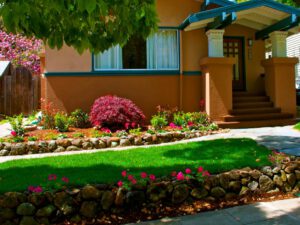Landscape design is the process of incorporating both nature and culture into the design of your garden or landscape. It is an independent profession that bridges landscape architecture and the garden design disciplines.
Landscaping designs are often characterized by form. This includes the shapes of plant material and hardscape elements.
The shapes of plants, structures, and landscape elements work together to create a sense of rhythm and harmony. Often, the shapes of plants are influenced by the shape of the house. Similarly, the shape of the home can influence the design of the yard.
Form composition is the use of lines and arcs to create geometric shapes. Lines and arcs are used to delineate hardscape areas and create a sense of unity and balance.
A line is created by the edge of a patio, flower bed, or the perimeter of a deck. These lines can be straight or curved. In a formal landscape, straight lines can be used to create a more rigid character.
In a more informal landscape, curved lines can give the appearance of mystery. Curved lines can also create a relaxed, natural feel.
The use of color can contribute to the overall visual impact of a design. Warm colors such as reds, yellows, and oranges are popular, but designers should also pay attention to cooler colors, such as blues. Color can also affect the amount of light that shines through the yard.
Proportion is a key factor in good design. It focuses on the relationship between objects of different sizes. This includes vertical relationships, horizontal relationships, and special relationships. When the proportion is not achieved, the features of the landscape will appear to lack harmony.
Color is an essential aspect of landscaping designs. Whether you’re planning a patio party or just want a relaxing retreat, it can make all the difference in your outdoor space. The right colors can unify a whole garden design or create a focal point for a patio. It’s a fact that some people are more attracted to vibrant warm tones, while others prefer a more neutral palette.
While there are numerous ways to incorporate color into your landscape, a few basic principles can guide you through the process. Using the color wheel is a great starting point. Taking a look at the color wheel’s color schemes will help you decide on a palette that best suits your project.
Aside from color, another important aspect of landscape design is context. In order to create a cohesive design, you’ll need to consider the size, scale, and shape of your garden and the impact that it will have on the environment. For instance, if your garden is next to an architectural feature, you’ll want to consider how that structure will affect the color scheme you choose.
Choosing the correct color for your landscape can be a daunting task. There are four techniques you can use to find the perfect color combination for your yard. By utilizing these tips, you’ll be well on your way to a successful design.
Although color can be overwhelming to some designers, it’s still a necessary component of your design. Creating a monochromatic scheme will allow you to play with your favorites while creating a unified look.
The texture is a very important aspect of landscaping design. Not only does it add depth to your landscape, but it also serves to draw attention to specific planting beds and features.
When it comes to plants, texture plays a big role in how the plant interacts with light. Creating contrast between the various textures in your garden can help to create an overall harmonious effect.
Adding new textures to an existing garden can also be a good way to introduce a new element. For example, adding a few burgundy florets to your perennial bed can provide a colorful and textured backdrop for your greenery.
Texture in landscaping designs can be achieved through many different methods. Generally, a good professional will combine several textures to create a cohesive look. It is important to balance the various textures in your landscape to avoid a cluttered or boring feel.
Visual texture is more important than tactile texture. It can be achieved through the use of bold colors or an emphasis on unique shapes.
